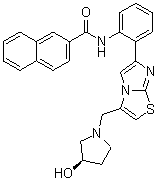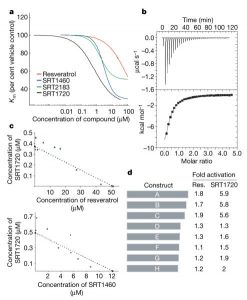This product is for research use only, not for human use. We do not sell to patients.

| Size | Price | Stock |
|---|---|---|
| 2mg | $135 | To Be Confirmed |
| 5mg | $210 | To Be Confirmed |
| 10mg | $360 | To Be Confirmed |
| 25mg | $750 | To Be Confirmed |
| 50mg | $1250 | To Be Confirmed |
| 100mg | $2050 | To Be Confirmed |
Cat #: V1188 CAS #: 1001908-89-9 Purity ≥ 98%
Description: SRT2183 (SRT 2183; SRT-2183) is a novel and potent small-molecule activator of the sirtuin subtype1-(SIRT1, EC50 =0.36 μM) developed by Sirtris Pharmaceuticals as therapeutics for the treatment of type 2 diabetes and potentially leukemia as well. SRT2183 has similar activity in the body to another SIRT1 activator SRT1720, but is closer in potency to resveratrol. In animal studies it was found to improve insulin sensitivity and lower plasma glucose levels in fat, muscle and liver tissue, and increased mitochondrial and metabolic function. However, the claim that SRT2183 is a SIRT1 activator has been questioned and further defended.
Publications Citing InvivoChem Products
Product Promise

- Physicochemical and Storage Information
- Protocol
- Related Biological Data
- Stock Solution Preparation
- Quality Control Documentation
| Molecular Weight (MW) | 468.57 |
|---|---|
| Molecular Formula | C27H24N4O2S |
| CAS No. | 1001908-89-9 |
| Storage | -20℃ for 3 years in powder form |
| -80℃ for 2 years in solvent | |
| Solubility In Vitro | DMSO: 93 mg/mL (198.5 mM) |
| Water: <1 mg/mL | |
| Ethanol: 3 mg/mL (6.4 mM) | |
| Synonyms | SRT2183; SRT 2183; SRT-2183. |
| Protocol | In Vitro | In vitro activity: SRT2183 is potent with growth arrest and apoptosis induced at doses ranging from 1-20 μM. SRT2183 treatment leads to increased mRNA levels of pro-apoptosis, growth arrest, and DNA damage response genes. SRT1720, SRT2183, SRT1460, and resveratrol exhibit multiple off-target activities against receptors, enzymes, transporters, and ion channels. They are not direct activators of SIRT1. SRT2183 has little or no effect on SIRT1 deacetylating activity with native full-length substrates. SRT2183 activates AMPK, increases Sirt1 expression and decreases RelA/p65 lysine310 acetylation, critical for NF-κB activation, and an established Sirt1 target and inhibits RANKL-induced osteoclast generation and resorptive capacity in bone marrow macrophages. Cell Assay: BMMs are harvested, plated and 24-hrs later non-adherent cells were re-plated at a density of 20,000 cells/well in α-MEM/15%FBS/5% M-CSF. For determining cell proliferation, cells are treated with SRT2183 or a vehicle for 72 hours post plating and BrdU reagent is added 48 hrs post SRT2183 or vehicle administration according to the manufacturer's instructions to determine cell proliferation 3 days post plating. |
|---|
| Solvent volume to be added | Mass (the weight of a compound) | |||
|---|---|---|---|---|
| Mother liquor concentration | 1mg | 5mg | 10mg | 20mg |
| 1mM | 2.1342 mL | 10.6708 mL | 21.3415 mL | 42.6831 mL |
| 5mM | 0.4268 mL | 2.1342 mL | 4.2683 mL | 8.5366 mL |
| 10mM | 0.2134 mL | 1.0671 mL | 2.1342 mL | 4.2683 mL |
| 20mM | 0.1067 mL | 0.5335 mL | 1.0671 mL | 2.1342 mL |
This equation is commonly abbreviated as: C1 V1 = C2 V2
- (1) Please be sure that the solution is clear before the addition of next solvent. Dissolution methods like vortex, ultrasound or warming and heat may be used to aid dissolving.
- (2) Be sure to add the solvent(s) in order.






































